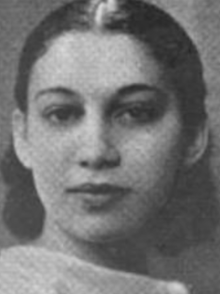Mabel Murphy Smythe-Haith (April 3, 1918 – February 7, 2006) was an American diplomat who served as Ambassador for the United States to Cameroon and later Equatorial Guinea, as well as the Deputy Assistant Secretary of State for African Affairs.
Mabel Murphy Smythe-Haith | |
|---|---|
 Mabel H. Murphy, from a 1937 magazine | |
| Born | April 3, 1918 Montgomery, Alabama, U.S. |
| Died | February 7, 2006 (aged 87) |
| Education | Northwestern University, University of Wisconsin |
| Spouse | Hugh H. Smythe |
Early life and education
editBorn in Montgomery, Alabama on April 3, 1918, Mabel Murphy Smythe-Haith was the daughter of Josephine Dibble and Henry Saunders Murphy. She had two older sisters and a younger brother. Both her parents were college educated and actively involved in the world of education. Her father began his career teaching at what is now Langston University. He later moved to what is now Alabama State where he stayed for several years before he accepted a job with the Standard Life Insurance Company to organize and run their printing division. Her mother spent a year as the dean of women at Fort Valley State College in Atlanta, Georgia, before becoming a “university hostess” at Atlanta University where she also served as the president of Alumni Association for twenty-two years. Smythe-Haith enrolled in Spelman College when she was 15 but transferred to Mount Holyoke College in Massachusetts to complete her bachelor's degree.[1] Two years after she received her bachelor's degree, she married Hugh H. Smythe. After her marriage, Smythe-Haith earned her master's degree from Northwestern University in 1940 and a doctoral degree in labor economics and law in 1942 from the University of Wisconsin.[2]
Career
editSmythe-Haith began her career as a professor. She taught briefly at three historically black institutions, Fort Valley State University, Lincoln University and Tennessee State University. Subsequently, Smythe-Haith taught economics at Brooklyn College in New York.[1] From 1951 to 1953 she taught economics and English at Shiga University in Japan, where she learned Japanese and co-authored a Japanese-English phrase book.[2]
In 1953, Smythe-Haith joined the NAACP Legal Defense and Education Fund as deputy director.[3] She worked alongside Thurgood Marshall and helped him prepare the Brown v. Board of Education desegregation case.
Smythe-Haith also worked with James Robinson, the founder of Operations Crossroads Africa, in 1958. She helped launch on a student-exchange program between Africa and the United States and also worked with college admission officers to help Nigerian students attend Harvard and other universities through the African Scholarship Program.[3] She also served as a consultant for Encyclopædia Britannica and Vice President of the Phelps Stokes Fund. She was also a trustee of the Cottonwood Foundation and worked with the United States Civil Rights Commission as the Scholar-in-Residence.[4]
In 1962, Smythe-Haith was appointed to the State Department's Advisory Council for African American Affairs by President John F. Kennedy.[5] President Jimmy Carter chose Smythe-Haith as U.S. Ambassador to Cameroon and the Republic of Equatorial Guinea in 1977.[6] She was only the second African-American women to be an ambassador.[1] She held these posts concurrently for three years.[7]
After her ambassadorship, she was the Deputy Assistant Secretary of State for African Affairs. From 1981 to 1985, she taught at Northwestern University and served as the Melville J. Heskovits professor and director of African studies.[8] After she retired in 1985, she served as a guest scholar at the Woodrow Wilson International Center for Scholars.[1]
Personal life
editSmythe-Haith married her first husband, Hugh H. Smythe, in 1939, after they met in Atlanta. The two had a daughter, Karen Pamela Smythe. Hugh Smythe died in 1978. In 1985, Smythe-Haith married retired hospital director, Robert Haith Jr., who died three years later.[9]
Smythe-Haith died on February 7, 2006, from Alzheimer's disease.[3]
References
edit- ^ a b c d "Smythe-Haith, Mabel Murphy (1918-2006) | The Black Past: Remembered and Reclaimed". www.blackpast.org. 30 January 2015. Retrieved 2016-11-03.
- ^ a b "Smythe-Haithe, Mabel - Dictionary definition of Smythe-Haithe, Mabel | Encyclopedia.com: FREE online dictionary". www.encyclopedia.com. Retrieved 2016-11-03.
- ^ a b c Sullivan, Patricia (2006-02-25). "Mabel Smythe-Haith; Envoy, State Department Official". The Washington Post. ISSN 0190-8286. Retrieved 2016-11-29.
- ^ Nolan, Cathal J. (1997-01-01). Notable U.S. Ambassadors Since 1775: A Biographical Dictionary. Greenwood Publishing Group. ISBN 9780313291951.
- ^ Nolan, Cathal J. (1997). Notable US Ambassadors Since 1775. Greenwood Publishing. ISBN 9780313291951. Retrieved 2016-11-03.
{{cite book}}:|website=ignored (help) - ^ "The Association for Diplomatic Studies and Training Foreign Affairs Oral History Project Women Ambassadors Series AMBASSADOR MABEL MURPHY SMYTHE (HAITH)" (PDF). Association for Diplomatic Studies and Training. 2 May 1986. Archived (PDF) from the original on 3 July 2024. Retrieved 5 August 2024.
- ^ Chirhart, Ann Short; Clark, Kathleen Ann (2014-01-01). Georgia Women: Their Lives and Times. University of Georgia Press. ISBN 9780820337845.
- ^ D'Amico, Francine (1996-01-01). "Review of Her Excellency: An Oral History of American Women Ambassadors". The Oral History Review. 23 (2): 104–107. doi:10.1093/ohr/23.2.104. JSTOR 3675856.
- ^ Anderson, Mark (2008-10-01). "The Complicated Career of Hugh Smythe … Anthropologist and Ambassador: The Early Years, 1940–50". Transforming Anthropology. 16 (2): 128–146. doi:10.1111/j.1548-7466.2008.00021.x. ISSN 1548-7466.